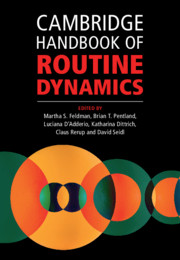Book contents
- Cambridge Handbook of Routine Dynamics
- Cambridge Handbook of Routine Dynamics
- Copyright page
- Contents
- Figures
- Tables
- Contributors
- Preface
- Chapter 1 What Is Routine Dynamics?
- Part I Theoretical Resources for Routine Dynamics Research
- Part II Methodological Issues in Routine Dynamics Research
- Part III Themes in Routine Dynamics Research
- Chapter 15 Truces and Routine Dynamics
- Chapter 16 Context, Embeddedness and Routine Dynamics
- Chapter 17 Routine Interdependence
- Chapter 18 Cognition and Routine Dynamics
- Chapter 19 Time, Temporality and History in Routine Dynamics
- Chapter 20 Replication and Routine Dynamics
- Chapter 21 Innovation Work and Routine Dynamics
- Chapter 22 Design and Routine Dynamics
- Chapter 23 Algorithms and Routine Dynamics
- Chapter 24 Complexity in Routine Dynamics
- Chapter 25 Bodies and Routine Dynamics
- Chapter 26 Emotions and Routine Dynamics
- Chapter 27 Professional Identity and Routine Dynamics
- Chapter 28 Occupations, Professions and Routine Dynamics
- Chapter 29 Routine Dynamics and Management Practice
- Chapter 30 Project-Based Temporary Organizing and Routine Dynamics
- Chapter 31 Self-Managed Forms of Organizing and Routine Dynamics
- Chapter 32 Unexpected Events and Routine Dynamics
- Part IV Related Communities of Thought
- Author Index
- Subject Index
- References
Chapter 29 - Routine Dynamics and Management Practice
from Part III - Themes in Routine Dynamics Research
Published online by Cambridge University Press: 11 December 2021
- Cambridge Handbook of Routine Dynamics
- Cambridge Handbook of Routine Dynamics
- Copyright page
- Contents
- Figures
- Tables
- Contributors
- Preface
- Chapter 1 What Is Routine Dynamics?
- Part I Theoretical Resources for Routine Dynamics Research
- Part II Methodological Issues in Routine Dynamics Research
- Part III Themes in Routine Dynamics Research
- Chapter 15 Truces and Routine Dynamics
- Chapter 16 Context, Embeddedness and Routine Dynamics
- Chapter 17 Routine Interdependence
- Chapter 18 Cognition and Routine Dynamics
- Chapter 19 Time, Temporality and History in Routine Dynamics
- Chapter 20 Replication and Routine Dynamics
- Chapter 21 Innovation Work and Routine Dynamics
- Chapter 22 Design and Routine Dynamics
- Chapter 23 Algorithms and Routine Dynamics
- Chapter 24 Complexity in Routine Dynamics
- Chapter 25 Bodies and Routine Dynamics
- Chapter 26 Emotions and Routine Dynamics
- Chapter 27 Professional Identity and Routine Dynamics
- Chapter 28 Occupations, Professions and Routine Dynamics
- Chapter 29 Routine Dynamics and Management Practice
- Chapter 30 Project-Based Temporary Organizing and Routine Dynamics
- Chapter 31 Self-Managed Forms of Organizing and Routine Dynamics
- Chapter 32 Unexpected Events and Routine Dynamics
- Part IV Related Communities of Thought
- Author Index
- Subject Index
- References
Summary
This Chapter discusses the potential and relevance of a practice perspective on management that sees routines and the dynamics of routines as an essential focus of managerial engagement. The Routine Dynamics research program has opened the door for this view on management, to understand how management shapes stability and change in organizations. The Chapter presents studies on the role of management in enacting routine performance, in reflecting routine dynamics, and in mobilizing specific settings to creating and changing routines. Furthermore, the study of management routines, essential for stability and change in managerial engagement itself, has recently gained attention, in the context of the Strategy-as-Practice research program. We explore the current state and identify promising opportunities for future research
Keywords
- Type
- Chapter
- Information
- Cambridge Handbook of Routine Dynamics , pp. 397 - 406Publisher: Cambridge University PressPrint publication year: 2021

